change key battery Seat Alhambra 2013 Owner's Manual
[x] Cancel search | Manufacturer: SEAT, Model Year: 2013, Model line: Alhambra, Model: Seat Alhambra 2013Pages: 387, PDF Size: 6.13 MB
Page 74 of 387
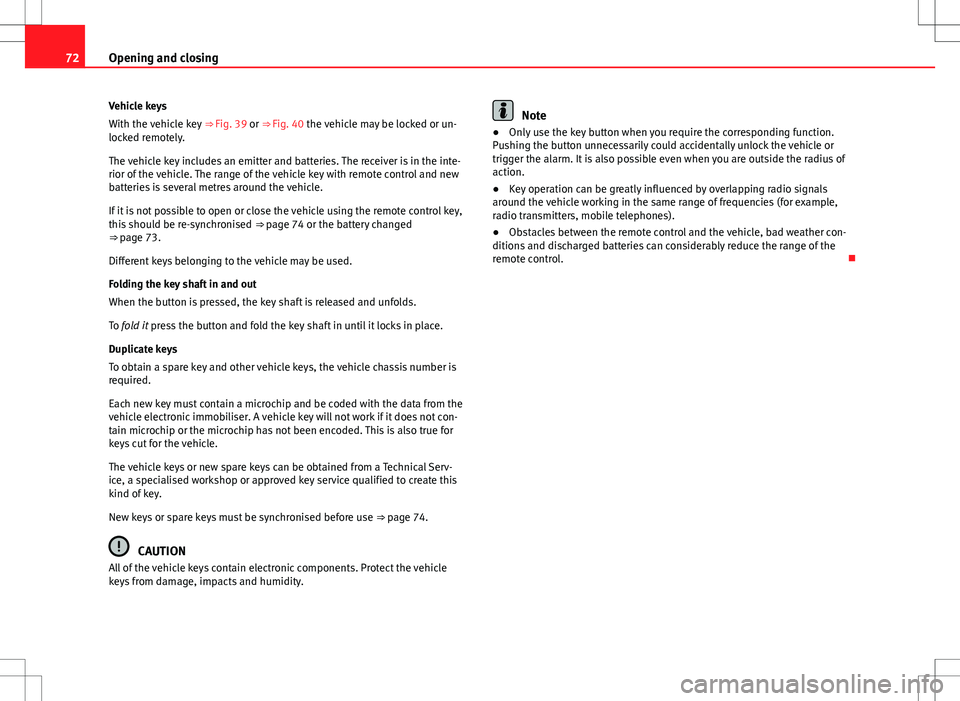
72Opening and closing
Vehicle keys
With the vehicle key ⇒ Fig. 39 or ⇒ Fig. 40 the vehicle may be locked or un-
locked remotely.
The vehicle key includes an emitter and batteries. The receiver is in the inte-
rior of the vehicle. The range of the vehicle key with remote control and new
batteries is several metres around the vehicle.
If it is not possible to open or close the vehicle using the remote control key,
this should be re-synchronised ⇒ page 74 or the battery changed
⇒ page 73.
Different keys belonging to the vehicle may be used.
Folding the key shaft in and out
When the button is pressed, the key shaft is released and unfolds.
To fold it press the button and fold the key shaft in until it locks in place.
Duplicate keys
To obtain a spare key and other vehicle keys, the vehicle chassis number is
required.
Each new key must contain a microchip and be coded with the data from the
vehicle electronic immobiliser. A vehicle key will not work if it does not con-
tain microchip or the microchip has not been encoded. This is also true for
keys cut for the vehicle.
The vehicle keys or new spare keys can be obtained from a Technical Serv-
ice, a specialised workshop or approved key service qualified to create this
kind of key.
New keys or spare keys must be synchronised before use ⇒ page 74.
CAUTION
All of the vehicle keys contain electronic components. Protect the vehicle
keys from damage, impacts and humidity.
Note
● Only use the key button when you require the corresponding function.
Pushing the button unnecessarily could accidentally unlock the vehicle or
trigger the alarm. It is also possible even when you are outside the radius of
action.
● Key operation can be greatly influenced by overlapping radio signals
around the vehicle working in the same range of frequencies (for example,
radio transmitters, mobile telephones).
● Obstacles between the remote control and the vehicle, bad weather con-
ditions and discharged batteries can considerably reduce the range of the
remote control.
Page 75 of 387
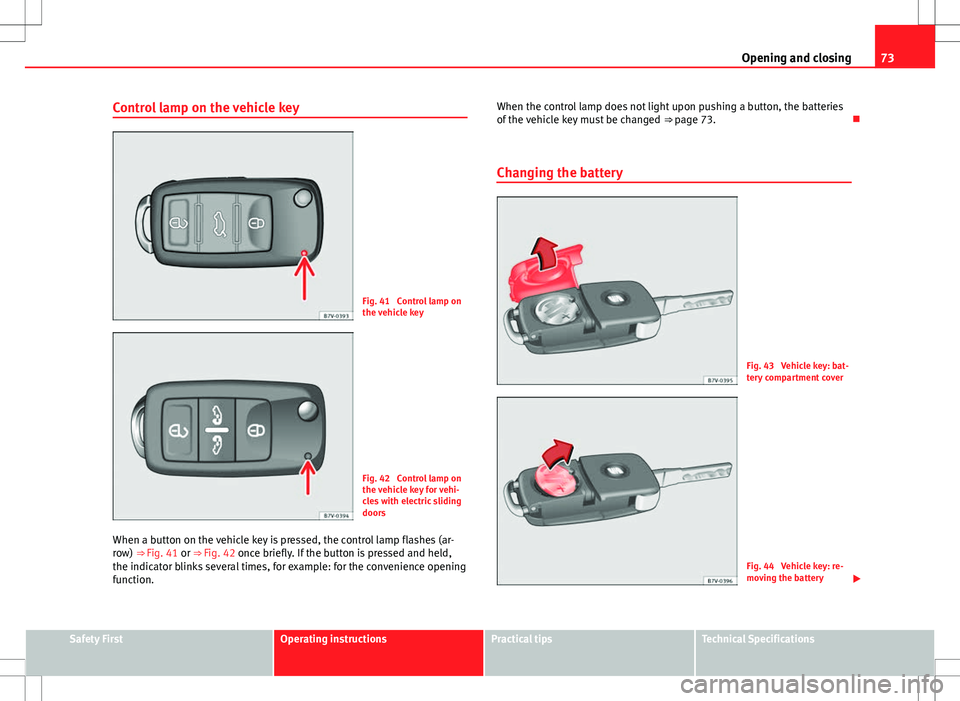
73
Opening and closing
Control lamp on the vehicle key
Fig. 41 Control lamp on
the vehicle key
Fig. 42 Control lamp on
the vehicle key for vehi-
cles with electric sliding
doors
When a button on the vehicle key is pressed, the control lamp flashes (ar-
row) ⇒ Fig. 41 or ⇒ Fig. 42 once briefly. If the button is pressed and held,
the indicator blinks several times, for example: for the convenience opening
function. When the control lamp does not light upon pushing a button, the batteries
of the vehicle key must be changed
⇒ page 73.
Changing the battery
Fig. 43 Vehicle key: bat-
tery compartment cover
Fig. 44 Vehicle key: re-
moving the battery
Safety FirstOperating instructionsPractical tipsTechnical Specifications
Page 76 of 387
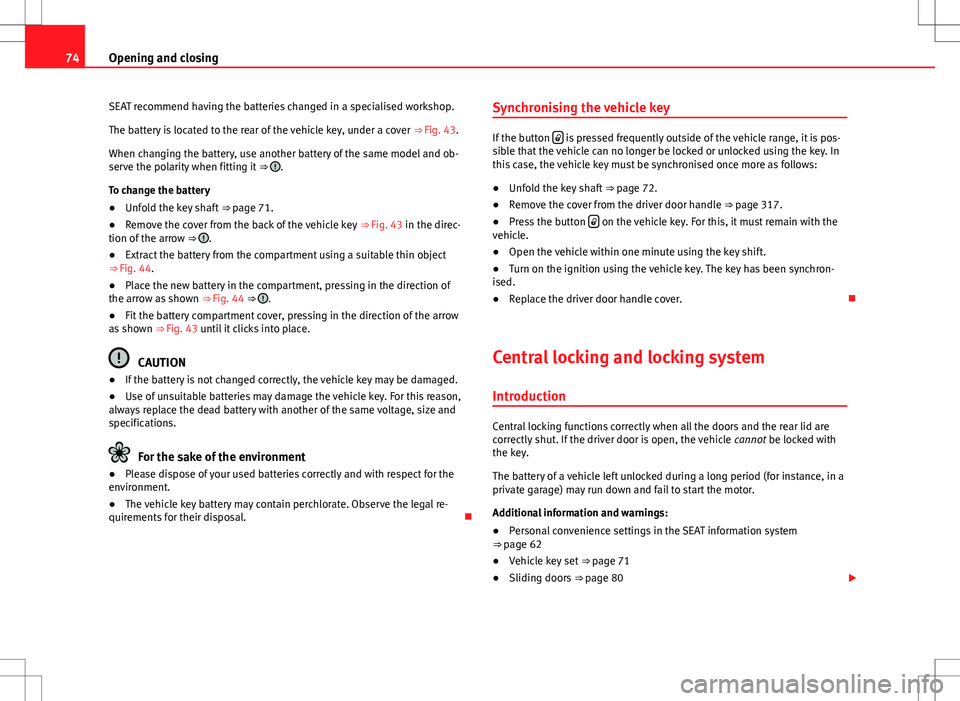
74Opening and closing
SEAT recommend having the batteries changed in a specialised workshop.
The battery is located to the rear of the vehicle key, under a cover ⇒ Fig. 43.
When changing the battery, use another battery of the same model and ob-
serve the polarity when fitting it ⇒
.
To change the battery
● Unfold the key shaft ⇒ page 71.
● Remove the cover from the back of the vehicle key ⇒ Fig. 43 in the direc-
tion of the arrow ⇒
.
● Extract the battery from the compartment using a suitable thin object
⇒ Fig. 44.
● Place the new battery in the compartment, pressing in the direction of
the arrow as shown ⇒ Fig. 44 ⇒
.
● Fit the battery compartment cover, pressing in the direction of the arrow
as shown ⇒ Fig. 43 until it clicks into place.
CAUTION
● If the battery is not changed correctly, the vehicle key may be damaged.
● Use of unsuitable batteries may damage the vehicle key. For this reason,
always replace the dead battery with another of the same voltage, size and
specifications.
For the sake of the environment
● Please dispose of your used batteries correctly and with respect for the
environment.
● The vehicle key battery may contain perchlorate. Observe the legal re-
quirements for their disposal. Synchronising the vehicle key
If the button
is pressed frequently outside of the vehicle range, it is pos-
sible that the vehicle can no longer be locked or unlocked using the key. In
this case, the vehicle key must be synchronised once more as follows:
● Unfold the key shaft ⇒ page 72.
● Remove the cover from the driver door handle ⇒ page 317.
● Press the button
on the vehicle key. For this, it must remain with the
vehicle.
● Open the vehicle within one minute using the key shift.
● Turn on the ignition using the vehicle key. The key has been synchron-
ised.
● Replace the driver door handle cover.
Central locking and locking system
Introduction
Central locking functions correctly when all the doors and the rear lid are
correctly shut. If the driver door is open, the vehicle cannot be locked with
the key.
The battery of a vehicle left unlocked during a long period (for instance, in a
private garage) may run down and fail to start the motor.
Additional information and warnings:
● Personal convenience settings in the SEAT information system
⇒ page 62
● Vehicle key set ⇒ page 71
● Sliding doors ⇒ page 80
Page 345 of 387
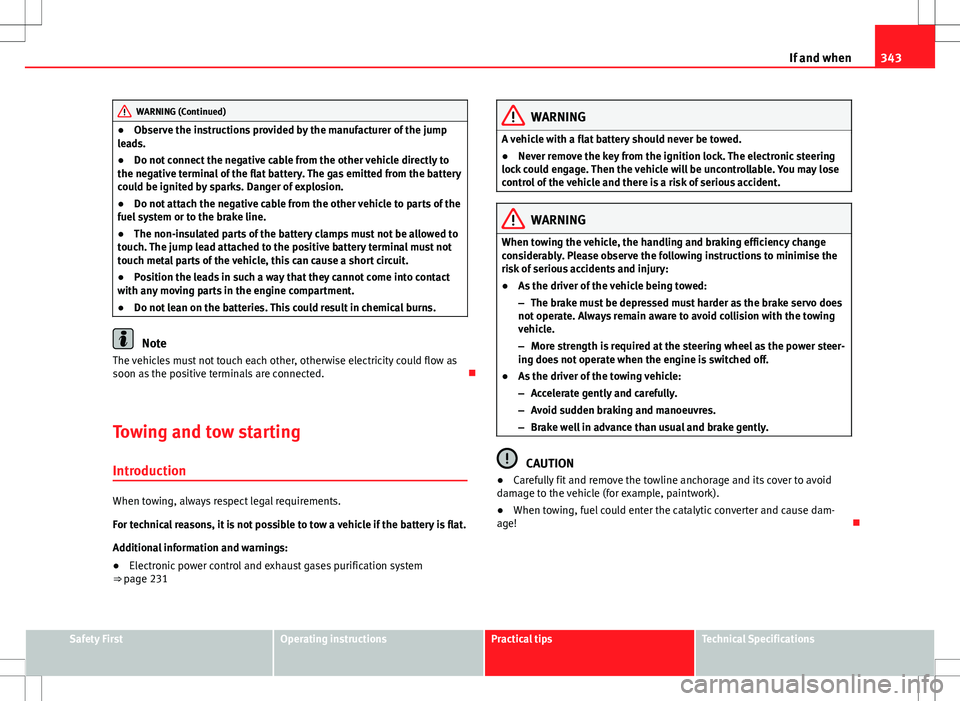
343
If and when
WARNING (Continued)
● Observe the instructions provided by the manufacturer of the jump
leads.
● Do not connect the negative cable from the other vehicle directly to
the negative terminal of the flat battery. The gas emitted from the battery
could be ignited by sparks. Danger of explosion.
● Do not attach the negative cable from the other vehicle to parts of the
fuel system or to the brake line.
● The non-insulated parts of the battery clamps must not be allowed to
touch. The jump lead attached to the positive battery terminal must not
touch metal parts of the vehicle, this can cause a short circuit.
● Position the leads in such a way that they cannot come into contact
with any moving parts in the engine compartment.
● Do not lean on the batteries. This could result in chemical burns.
Note
The vehicles must not touch each other, otherwise electricity could flow as
soon as the positive terminals are connected.
Towing and tow starting Introduction
When towing, always respect legal requirements.
For technical reasons, it is not possible to tow a vehicle if the battery is flat.
Additional information and warnings:
● Electronic power control and exhaust gases purification system
⇒ page 231
WARNING
A vehicle with a flat battery should never be towed.
● Never remove the key from the ignition lock. The electronic steering
lock could engage. Then the vehicle will be uncontrollable. You may lose
control of the vehicle and there is a risk of serious accident.
WARNING
When towing the vehicle, the handling and braking efficiency change
considerably. Please observe the following instructions to minimise the
risk of serious accidents and injury:
● As the driver of the vehicle being towed:
– The brake must be depressed must harder as the brake servo does
not operate. Always remain aware to avoid collision with the towing
vehicle.
– More strength is required at the steering wheel as the power steer-
ing does not operate when the engine is switched off.
● As the driver of the towing vehicle:
– Accelerate gently and carefully.
– Avoid sudden braking and manoeuvres.
– Brake well in advance than usual and brake gently.
CAUTION
● Carefully fit and remove the towline anchorage and its cover to avoid
damage to the vehicle (for example, paintwork).
● When towing, fuel could enter the catalytic converter and cause dam-
age!
Safety FirstOperating instructionsPractical tipsTechnical Specifications
Page 371 of 387
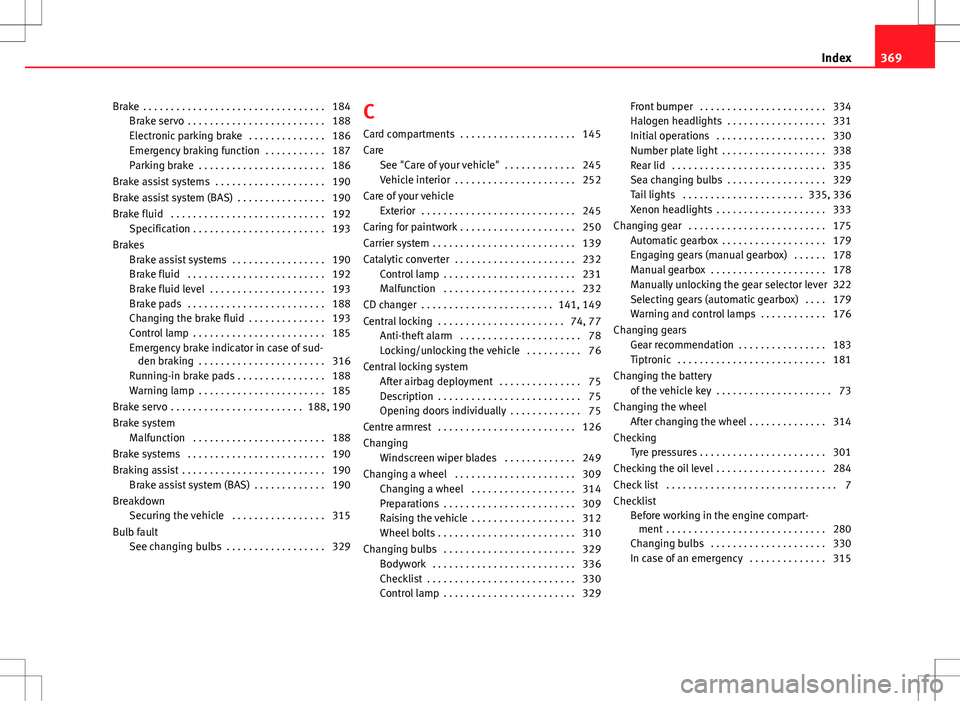
Brake . . . . . . . . . . . . . . . . . . . . . . . . . . . . . . . . . 184Brake servo . . . . . . . . . . . . . . . . . . . . . . . . . 188
Electronic parking brake . . . . . . . . . . . . . . 186
Emergency braking function . . . . . . . . . . . 187
Parking brake . . . . . . . . . . . . . . . . . . . . . . . 186
Brake assist systems . . . . . . . . . . . . . . . . . . . . 190
Brake assist system (BAS) . . . . . . . . . . . . . . . . 190
Brake fluid . . . . . . . . . . . . . . . . . . . . . . . . . . . . 192 Specification . . . . . . . . . . . . . . . . . . . . . . . . 193
Brakes Brake assist systems . . . . . . . . . . . . . . . . . 190
Brake fluid . . . . . . . . . . . . . . . . . . . . . . . . . 192
Brake fluid level . . . . . . . . . . . . . . . . . . . . . 193
Brake pads . . . . . . . . . . . . . . . . . . . . . . . . . 188
Changing the brake fluid . . . . . . . . . . . . . . 193
Control lamp . . . . . . . . . . . . . . . . . . . . . . . . 185
Emergency brake indicator in case of sud-den braking . . . . . . . . . . . . . . . . . . . . . . . 316
Running-in brake pads . . . . . . . . . . . . . . . . 188
Warning lamp . . . . . . . . . . . . . . . . . . . . . . . 185
Brake servo . . . . . . . . . . . . . . . . . . . . . . . . 188, 190
Brake system Malfunction . . . . . . . . . . . . . . . . . . . . . . . . 188
Brake systems . . . . . . . . . . . . . . . . . . . . . . . . . 190
Braking assist . . . . . . . . . . . . . . . . . . . . . . . . . . 190 Brake assist system (BAS) . . . . . . . . . . . . . 190
Breakdown Securing the vehicle . . . . . . . . . . . . . . . . . 315
Bulb fault See changing bulbs . . . . . . . . . . . . . . . . . . 329 C
Card compartments . . . . . . . . . . . . . . . . . . . . . 145
Care See "Care of your vehicle" . . . . . . . . . . . . . 245
Vehicle interior . . . . . . . . . . . . . . . . . . . . . . 252
Care of your vehicle Exterior . . . . . . . . . . . . . . . . . . . . . . . . . . . . 245
Caring for paintwork . . . . . . . . . . . . . . . . . . . . . 250
Carrier system . . . . . . . . . . . . . . . . . . . . . . . . . . 139
Catalytic converter . . . . . . . . . . . . . . . . . . . . . . 232 Control lamp . . . . . . . . . . . . . . . . . . . . . . . . 231
Malfunction . . . . . . . . . . . . . . . . . . . . . . . . 232
CD changer . . . . . . . . . . . . . . . . . . . . . . . . 141, 149
Central locking . . . . . . . . . . . . . . . . . . . . . . . 74, 77 Anti-theft alarm . . . . . . . . . . . . . . . . . . . . . . 78
Locking/unlocking the vehicle . . . . . . . . . . 76
Central locking system After airbag deployment . . . . . . . . . . . . . . . 75
Description . . . . . . . . . . . . . . . . . . . . . . . . . . 75
Opening doors individually . . . . . . . . . . . . . 75
Centre armrest . . . . . . . . . . . . . . . . . . . . . . . . . 126
Changing Windscreen wiper blades . . . . . . . . . . . . . 249
Changing a wheel . . . . . . . . . . . . . . . . . . . . . . 309 Changing a wheel . . . . . . . . . . . . . . . . . . . 314
Preparations . . . . . . . . . . . . . . . . . . . . . . . . 309
Raising the vehicle . . . . . . . . . . . . . . . . . . . 312
Wheel bolts . . . . . . . . . . . . . . . . . . . . . . . . . 310
Changing bulbs . . . . . . . . . . . . . . . . . . . . . . . . 329 Bodywork . . . . . . . . . . . . . . . . . . . . . . . . . . 336
Checklist . . . . . . . . . . . . . . . . . . . . . . . . . . . 330
Control lamp . . . . . . . . . . . . . . . . . . . . . . . . 329 Front bumper . . . . . . . . . . . . . . . . . . . . . . . 334
Halogen headlights . . . . . . . . . . . . . . . . . . 331
Initial operations . . . . . . . . . . . . . . . . . . . . 330
Number plate light . . . . . . . . . . . . . . . . . . . 338
Rear lid . . . . . . . . . . . . . . . . . . . . . . . . . . . . 335
Sea changing bulbs . . . . . . . . . . . . . . . . . . 329
Tail lights . . . . . . . . . . . . . . . . . . . . . . 335, 336
Xenon headlights . . . . . . . . . . . . . . . . . . . . 333
Changing gear . . . . . . . . . . . . . . . . . . . . . . . . . 175 Automatic gearbox . . . . . . . . . . . . . . . . . . . 179
Engaging gears (manual gearbox) . . . . . . 178
Manual gearbox . . . . . . . . . . . . . . . . . . . . . 178
Manually unlocking the gear selector lever . .322
Selecting gears (automatic gearbox) . . . . 179
Warning and control lamps . . . . . . . . . . . . 176
Changing gears Gear recommendation . . . . . . . . . . . . . . . . 183
Tiptronic . . . . . . . . . . . . . . . . . . . . . . . . . . . 181
Changing the battery of the vehicle key . . . . . . . . . . . . . . . . . . . . . 73
Changing the wheel After changing the wheel . . . . . . . . . . . . . . 314
Checking Tyre pressures . . . . . . . . . . . . . . . . . . . . . . . 301
Checking the oil level . . . . . . . . . . . . . . . . . . . . 284
Check list . . . . . . . . . . . . . . . . . . . . . . . . . . . . . . . 7
Checklist Before working in the engine compart-ment . . . . . . . . . . . . . . . . . . . . . . . . . . . . . 280
Changing bulbs . . . . . . . . . . . . . . . . . . . . . 330
In case of an emergency . . . . . . . . . . . . . . 315
369
Index